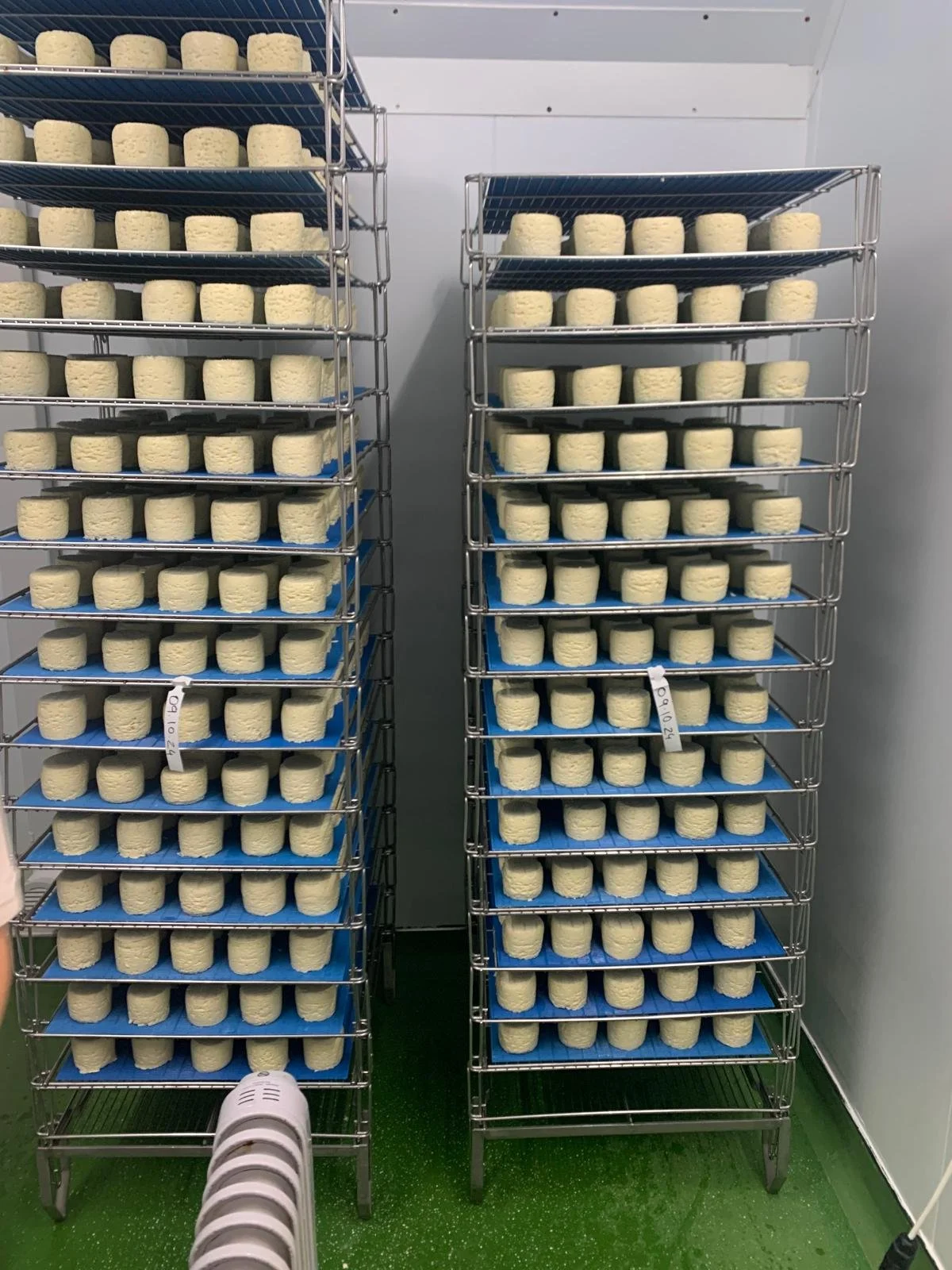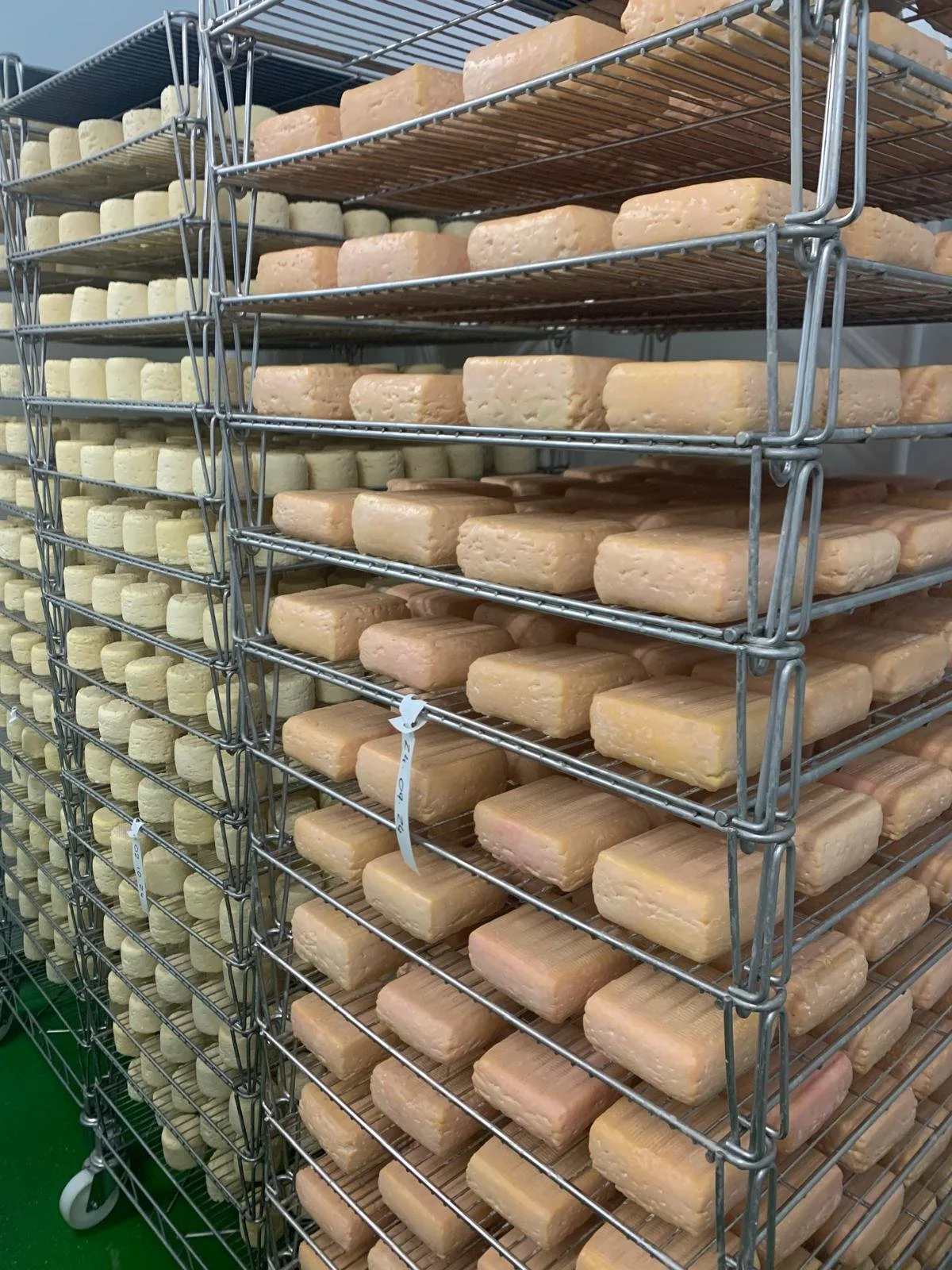Why we should all eat cheese to promote our gut health
By Sabrina Longley, Nettlebed Creamery, Henley-on-Thames
“Cheese” and “gut health” aren’t usually considered synonymous. Yes, cheese is undeniably high in fat and salt, rendering it often considered an “unhealthy” food product. However, in this article I will try to convince you otherwise.
First, a bit of background into my obsession with cheese. In 2018 I took a job as an assistant cheesemaker having just graduated from my biomedical sciences degree during what was supposed to be a gap year whilst I decided the next stage of my career, however I found myself utterly fascinated with the science and art of cheesemaking and so one year turned into six! Along the way, I completed a master’s degree in molecular microbiology and I am now two years into a part-time PhD in food and nutritional sciences, studying the cheeses I make and their potential for influencing the gut microbiota, all the while spending every Monday morning armpit deep in curds and whey. Suffice to say, I really like cheese!
For those who don’t know, cheese is made by taking milk, sometimes pasteurising it, and then adding starter cultures which primarily are designed to ferment the lactose into lactic acid as a key part of the cheesemaking process, but also are curated to influence the ultimate flavour and appearance of the cheese. After this, the milk is allowed to coagulate, either by acidification of the milk by the lactic acid bacteria, or by the addition of rennet; rennet is a combination of chymosin and pepsin which facilitates the formation of bonds between casein micelles to create a protein matrix which traps fat, moisture, and minerals. Once set, the curd is cut into pieces from which whey drains out during stirring, and these curds are ladled into your desired shaped moulds. The cheese is then salted, and the aging process can begin. Whilst this sounds simple, every single stage has several variables which will influence the desired product, from temperature at all stages, the starter cultures used, time between each stage, and the procedures involved in the aging (“affinage”), to name a few.
My primary interest in cheesemaking is the starter cultures. Many of the cultures used to create cheese are already recognised as potential probiotics, such as Lactococcus lactis, Lactobacillus delbrueckii subsp. bulgaricus, and Streptococcus salivarius subsp. thermophilus, due to recognition of species-level benefits. So far in my studies, I have sequenced the cheeses I produce at different stages of maturation and found the presence of these cultures in the mature (ready for sale and consumption) samples. This is consistent with recently published work showing that Lc. lactis and S. thermophilus are among the most abundant bacteria present cheeses made in 73 different facilities across Europe (1). It is believed that the cheese matrix of fat and protein has a protective effect on the cultures within (2), making it more likely that these will survive through the digestive tract in order to colonise the large intestine and thereby making cheese an excellent candidate for probiotic delivery.
The relative abundance of the three varieties of cheese made at Nettlebed Creamery throughout aging, represented at genus and species level. Bix is a soft, mould-ripened cheese; as the 16S amplicon sequencing method involves detection of only bacterial species, the moulds and yeasts used in this cheese are not represented, only the lactic acid bacteria used in the cheese-making process. Highmoor is a semi-soft washed rind cheese; as it matures, increases in the bacteria that form the rind can be seen (Mostly Corynebacterium spp. And Brevibacterium spp.). Witheridge is a semi-hard mature alpine-style cheese which is aged in hay; the addition of hay, which occurs between the "young" and "mid" sampling points, results in the huge increase in "other" species of bacteria present. The Raw Witheridge sample is taken from an experimental batch of Witheridge made with unpasteurised milk and was not aged in hay; the abundance of "other" species of bacteria is thought to come from the bacteria present in the unpasteurised milk.
My next phase of research involves testing the potential of these cheeses to affect the gut microbial populations in in vitro models. This work is still underway and so no results are available yet, however research has shown that consumption of cheese can modulate the gut microbiome. From a large scale study assessing the effect of consumption of different types of dairy, which found that regular consumption of cheese resulted in a reduced prevalence of Eisenbergiella sp. which may serve as a biomarker for infection and is a member of the Lachnispiraceae family which is associated with metabolic disorders and type 2 diabetes (3). To smaller scale human trials; one involving daily consumption of Camembert and another involving daily consumption of Parmesan, both resulting in the detection of cheese-derived bacteria found in the faeces of participants both during the consumption period and persisting beyond (4,5). In mice, consumption of an Emmental-style cheese during DSS-induced colitis resulted in a different microbial structure change compared to the control, with a concurrent increased immune response and reduced overall tissue damage (6). Similarly, mice with induced dermatitis fed cream cheese enriched with Lactococcus chungangensis CAU 28 had altered gut microbial populations and a modulated immune response resulting in a reduced dermatitis score (7).
In terms of wider health connotations, cheese is extremely nutrient rich and research continues to show that it has potential health benefits far above what has previously been assumed. For instance, cheese has a high protein content, mostly caseins which can be proteolyzed (either during the fermentation process or in the small intestine) into bioactive peptides such as lactotripeptides; these can inhibit angiotensin-converting enzyme (ACE) to prevent the formation of angiotensin 2 and thus can reduce blood pressure due to the reduction in vasoconstriction (8). The presence of calcium, which is known to increase bone mineral density, can also be beneficial for cardiovascular health by reducing serum cholesterol levels by binding with bile acids which necessitates their regeneration in the liver from cholesterol, and by reducing fat absorption by the formation of soaps in the small intestine (9–11). Contrary to popular belief, regular consumption of cheese is associated with a lower BMI and reduced weight gain across 5 years, thought to be due to the reduced fat absorption and increased faecal fat excretion due to calcium or by the increased satiety induced by cheese and associated reduced appetite (12,13). Cheese is also very rich in vitamins, containing all vitamins aside from vitamin C, which is broken down during pasteurisation; the presence of vitamin D and vitamin K2 is thought to drive an observed reduction in the risk of Type 2 Diabetes Mellitus observed following daily consumption of dairy products (14,15).
Hopefully by now I have convinced you of the virtues of cheese or, at the very least, given you an excuse to go and eat some cheese guilt-free!
References:
1. De Filippis F, Valentino V, Yap M, Cabrera-Rubio R, Barcenilla C, Carlino N, et al. Microbiome mapping in dairy industry reveals new species and genes for probiotic and bioprotective activities. npj Biofilms Microbiomes 2024 101 [Internet]. 2024 Aug 2 [cited 2024 Sep 5];10(1):1–16. Available from: https://www.nature.com/articles/s41522-024-00541-5
2. Leeuwendaal NK, Hayes JJ, Stanton C, O’Toole PW, Beresford TP. Protection of candidate probiotic lactobacilli by Cheddar cheese matrix during simulated gastrointestinal digestion. J Funct Foods. 2022 May 1;92:105042.
3. Aslam H, Collier F, Davis JA, Quinn TP, O’Hely M, Pasco JA, et al. Gut Microbiome Diversity and Composition Are Associated with Habitual Dairy Intakes: A Cross-Sectional Study in Men. J Nutr. 2021 Nov 1;151(11):3400–12.
4. Firmesse O, Alvaro E, Mogenet A, Bresson JL, Lemée R, Le Ruyet P, et al. Fate and effects of Camembert cheese micro-organisms in the human colonic microbiota of healthy volunteers after regular Camembert consumption. Int J Food Microbiol. 2008 Jul 15;125(2):176–81.
5. Milani C, Duranti S, Napoli S, Alessandri G, Mancabelli L, Anzalone R, et al. Colonization of the human gut by bovine bacteria present in Parmesan cheese. Nat Commun [Internet]. 2019 Dec 1 [cited 2024 Mar 19];10(1). Available from: /pmc/articles/PMC6426854/
6. Carvalho RD de O, Rabah H, Ariute JC, Aburjaile FF, Brenig B, Guédon E, et al. Functional Swiss-type cheeses promote beneficial effects in mice gut microbiome during homeostasis and inflammation. Food Biosci. 2023 Dec 1;56:103327.
7. Kim JH, Kim K, Kim W. Cream Cheese-Derived Lactococcus chungangensis CAU 28 Modulates the Gut Microbiota and Alleviates Atopic Dermatitis in BALB/c Mice. Sci Rep [Internet]. 2019 Dec 1 [cited 2024 Mar 19];9(1). Available from: /pmc/articles/PMC6345912/
8. Ricci I, Artacho R, Olalla M. Milk protein peptides with angiotensin I-Converting enzyme inhibitory (ACEI) activity. Crit Rev Food Sci Nutr [Internet]. 2010 May [cited 2024 Sep 20];50(5):390–402. Available from: https://www.tandfonline.com/action/journalInformation?journalCode=bfsn20
9. Caroli A, Poli A, Ricotta D, Banfi G, Cocchi D. Invited review: Dairy intake and bone health: A viewpoint from the state of the art1. J Dairy Sci [Internet]. 2011 Nov 1 [cited 2024 Sep 20];94(11):5249–62. Available from: http://www.journalofdairyscience.org/article/S0022030211005522/fulltext
10. Soerensen K V., Thorning TK, Astrup A, Kristensen M, Lorenzen JK. Effect of dairy calcium from cheese and milk on fecal fat excretion, blood lipids, and appetite in young men. Am J Clin Nutr. 2014 May 1;99(5):984–91.
11. Ditscheid B, Keller S, Jahreis G. Cholesterol Metabolism Is Affected by Calcium Phosphate Supplementation in Humans. J Nutr. 2005 Jul 1;135(7):1678–82.
12. Samara A, Herbeth B, Ndiaye NC, Fumeron F, Billod S, Siest G, et al. Dairy product consumption, calcium intakes, and metabolic syndrome–related factors over 5 years in the STANISLAS study. Nutrition. 2013 Mar 1;29(3):519–24.
13. Rosell M, Håkansson NN, Wolk A. Association between dairy food consumption and weight change over 9 y in 19 352 perimenopausal women. Am J Clin Nutr. 2006 Dec 1;84(6):1481–8.
14. Tremblay A, Gilbert JA. Milk products, insulin resistance syndrome and type 2 diabetes. J Am Coll Nutr [Internet]. 2009 Feb 1 [cited 2024 Sep 20];28:91S-102S. Available from: https://www.tandfonline.com/action/journalInformation?journalCode=uacn21
15. Gao D, Ning N, Wang C, Wang Y, Li Q, Meng Z, et al. Dairy Products Consumption and Risk of Type 2 Diabetes: Systematic Review and Dose-Response Meta-Analysis. PLoS One [Internet]. 2013 Sep 27 [cited 2024 Sep 20];8(9):e73965. Available from: https://journals.plos.org/plosone/article?id=10.1371/journal.pone.0073965





